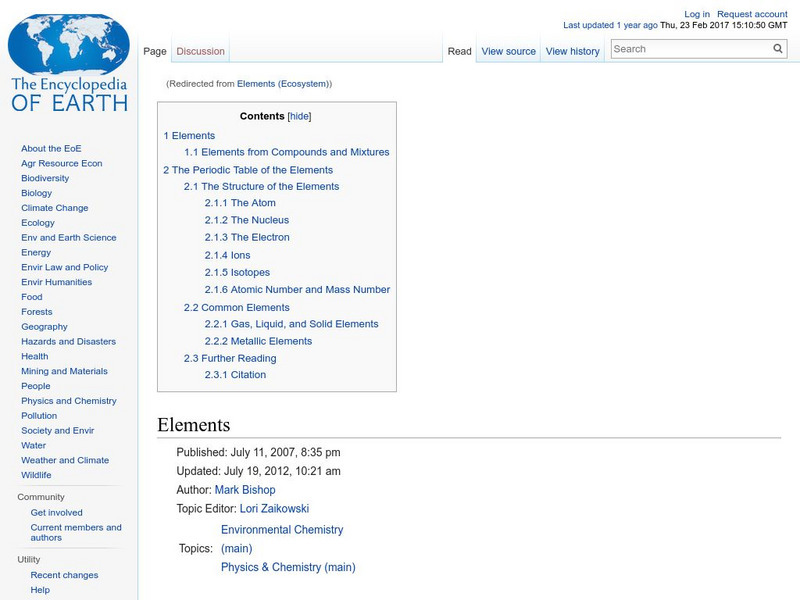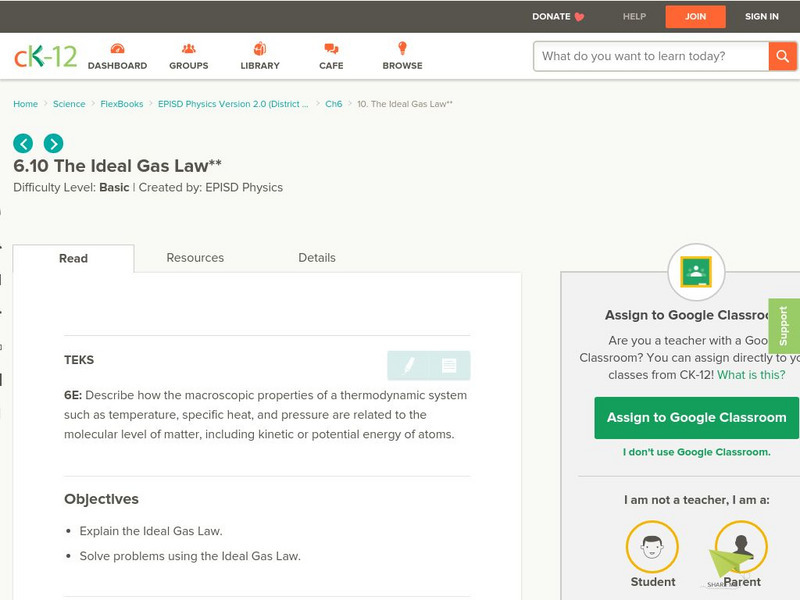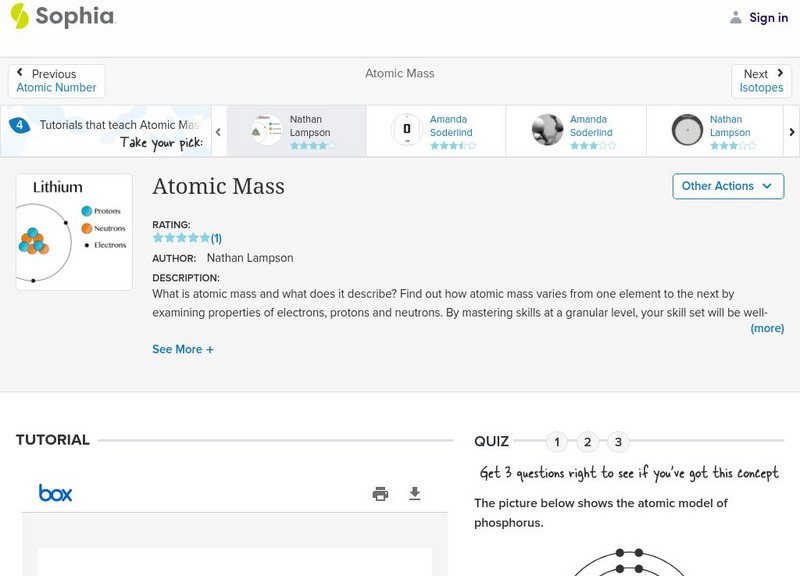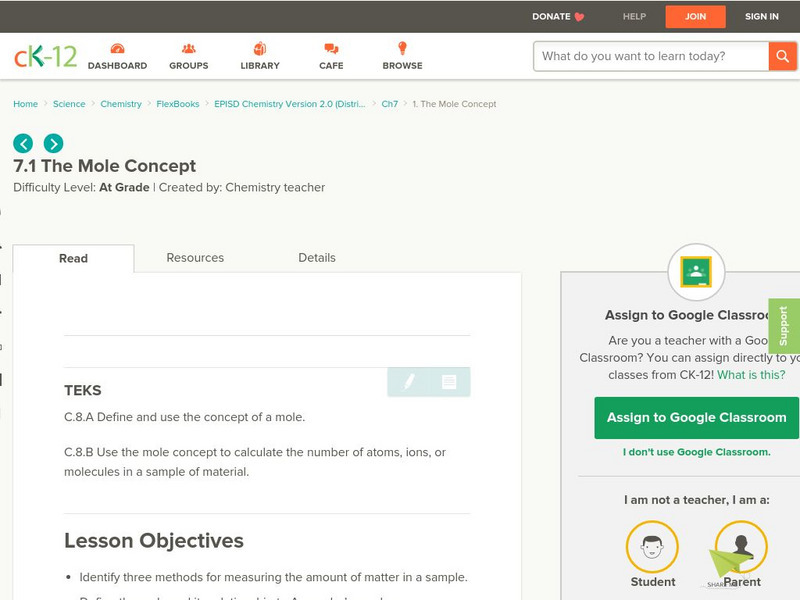Encyclopedia of Earth
Encyclopedia of Earth: Elements
Engaging and very informative article that explains what elements are, some of their history, how they are represented, the categories of elements, the periodic table, and how they are structured and classified.
Environmental Chemistry
Environmental chemistry.com: Anatomy of an Atom
Explains the basics of atomic structure, from simple definitions to information about quantum theory. Accurate and helpful basics whether or not you need the more advanced information.
CK-12 Foundation
Ck 12: The Ideal Gas Law
[Free Registration/Login may be required to access all resource tools.] Students read about and explore video clips, diagrams, and example problems using the Ideal Gas Law.
Science Struck
Science Struck: List of Radioactive Elements
Learn about radioactivity, the different types of radioactive decay, isotopes, and half-life of a radioactive element. Includes a long chart listing radioactive elements, atomic number and mass number, decay type, and length of half-life.
CK-12 Foundation
Ck 12: Chemistry: Calculating Atomic Mass
[Free Registration/Login may be required to access all resource tools.] Covers definition of atomic mass and calculations of atomic mass.
CK-12 Foundation
Ck 12: Chemistry Simulation: Average Atomic Mass
[Free Registration/Login Required] Students explore how percent abundances of different isotopes affect the average atomic mass for that given element. Students form connections between the average atomic mass and a person's body mass....
Wikimedia
Wikipedia: Atomic Number
Wikipedia provides the definition of the term, "Atomic number," a term used in chemistry and physics to represent the number of protons in the nucleus of an atom.
Sophia Learning
Sophia: Atomic Mass: Lesson 3
This lesson explains what is represented by the atomic mass, and how it varies from one element to the next. It is 3 of 4 in the series titled "Atomic Mass."
Sophia Learning
Sophia: Atomic Mass: Lesson 1
This lesson explains what is represented by the atomic mass, and how it varies from one element to the next. It is 1 of 4 in the series titled "Atomic Mass."
Sophia Learning
Sophia: Atomic Mass: Lesson 2
This lesson explains what is represented by the atomic mass, and how it varies from one element to the next. It is 2 of 4 in the series titled "Atomic Mass."
Sophia Learning
Sophia: Atomic Mass: Lesson 4
This lesson explains what is represented by the atomic mass, and how it varies from one element to the next. Module includes a slideshow and a quiz.
CK-12 Foundation
Ck 12 Exploration Series: Simulations: Physics: Tire Pressure
[Free Registration/Login Required] Uncover the relationship between pressure, force, and contact area in the context of a fire truck. Play with vehicle mass, number of tires, and guage pressure with this simulation to see what...
Science Struck
Science Struck: How to Find Protons, Neutrons and Electrons
Brief explanations of how to determine how many protons, neutrons, and electrons are in an element.
CK-12 Foundation
Ck 12: The Mole Concept
[Free Registration/Login may be required to access all resource tools.] In the following online tutorial students will identify three methods for measuring the amount of matter in a sample. They will define the mole and its relationship...
Other
Characteristics of Energy and Matter
A lengthy page from the Fundamentals of Physical Geography site. Energy is distinguished from matter, and the different forms of energy are identified and discussed. Four types of heat transfer (convection, advection, conduction,...
Simon Fraser University
Chem1 Virtual Textbook: Moles and Their Uses
As part of the "Basic Atomics" section of the Virtual Textbook, this site examines moles. The information presented defines moles in relation to Avogadro's number and then goes on to describe molar mass and molar volume.
Science Struck
Science Struck: Periodic Table With Atomic Mass
Explains how Dmitri Mendeleev created the periodic table of elements, how it was organized, the changes made by Henry Moseley in 1931, some characteristics of element groups, and what the atomic mass, number, and abbreviation each...
Dartmouth College
Dartmouth College: Chem Lab: Electrons in a Box
This site has an interactive component that allows you to change the mass, number of electrons and the length of the box and see how it affects the energy levels. Requires Java.
California State University
California State University: Proton, Electron, Neutron
An interesting and useful tool to practice recognition/calculation of atomic number, mass, and number of neutrons, electrons, etc. Can be used with all elements.
Mocomi & Anibrain Digital Technologies
Mocomi: Structure of an Atom
An atom is made of three parts - protons, neutrons, and electrons. Here you can explore these different parts.












